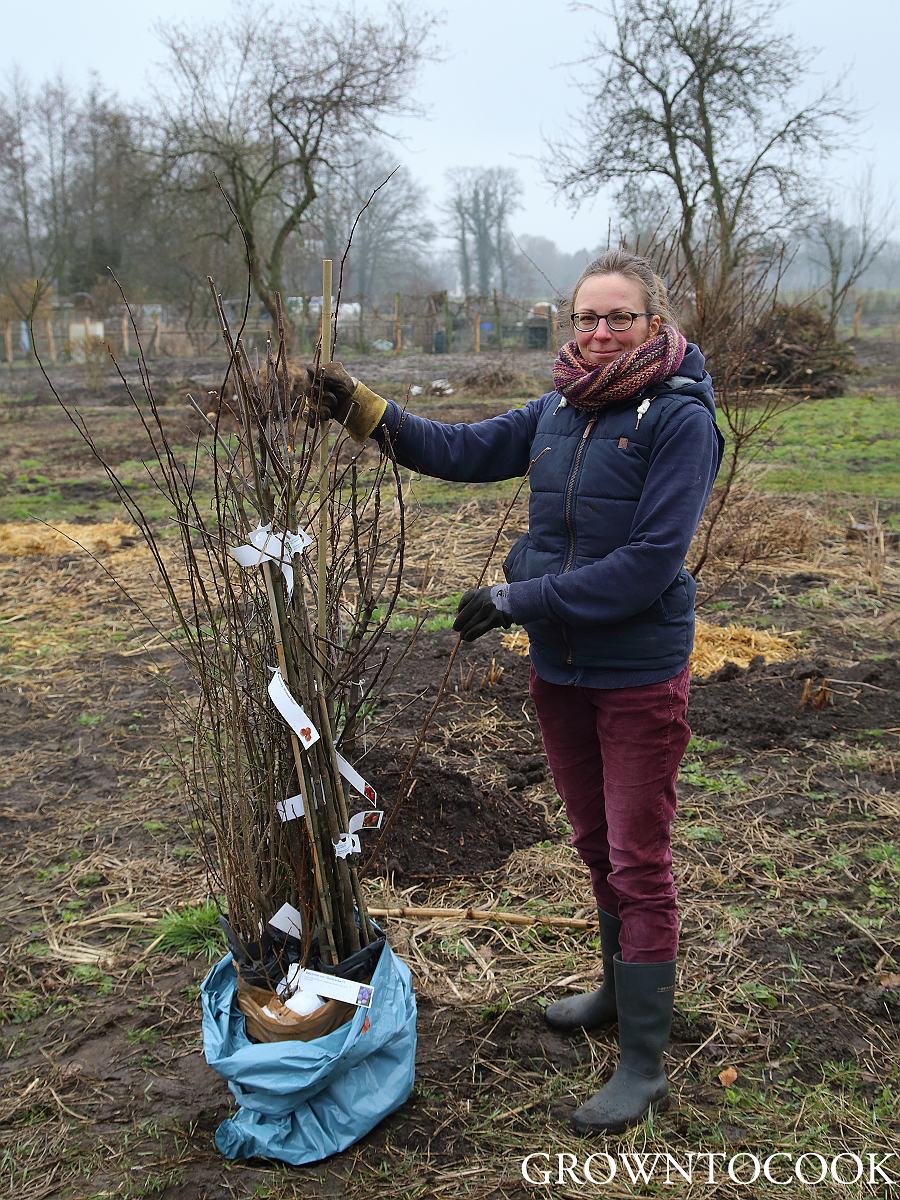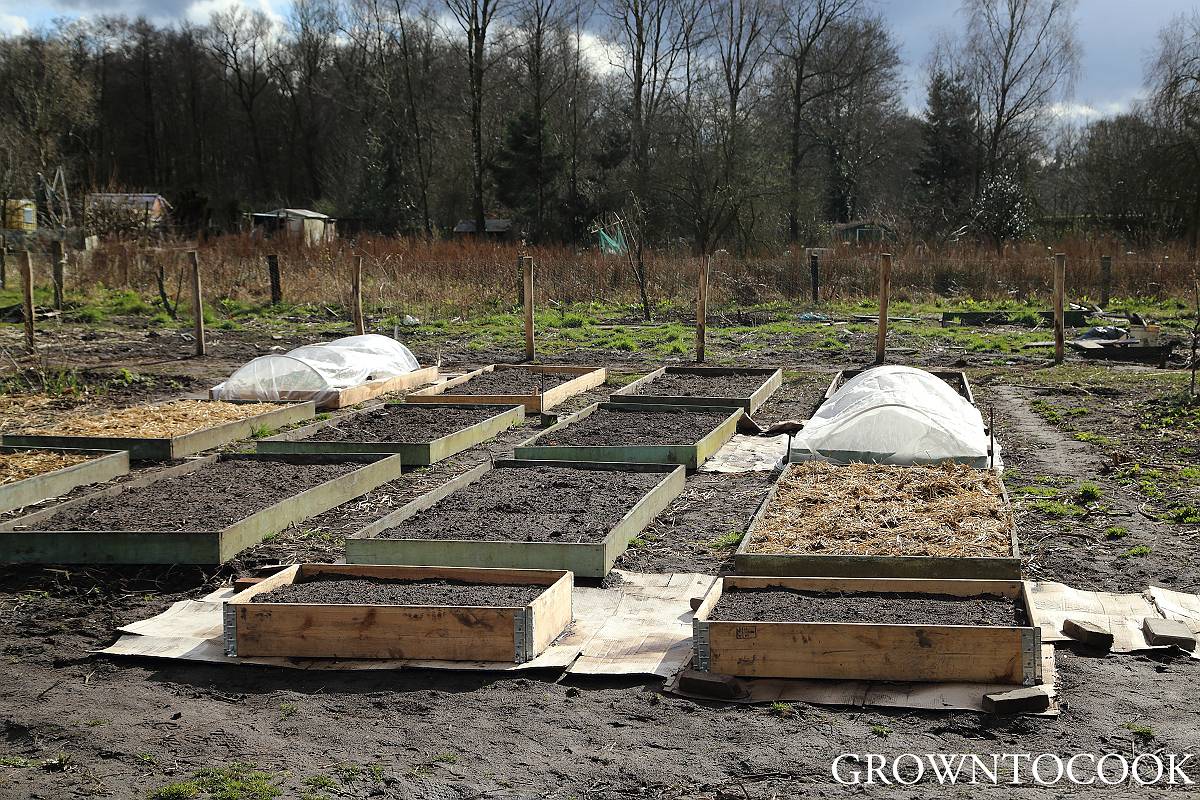
So….my back kind of hurts but I am also very happy because we got a ton of things done in the garden during the Easter weekend. It was a 5 day-weekend for us because we both took time off from (other) work to get all the trees and the hedge planted. The photo above was taken on Easter Sunday when we were rewarded with an incredible rainbow.

I ordered all the barefoot trees from a nursery close by and they arrived on Thursday which was perfect. The trees are grown organically and the nursery is also on sandy soil which means they should (hopefully) do well in our garden, too. In the end we narrowed the apple varieties down to ‘Gravensteiner’, ‘Glockenapfel’ and ‘Ecolette’. We have not yet managed to transplant our old trees from the other garden and it might be better to wait till fall with that.

Edible hedge
I got some questions about our edible hedge on Instagram and promised to answer them in a blogpost. We decided to plant a hedge along two sides of the plot – roughly north and east. On these sides the garden borders a path and we wanted to create some privacy and also protection against the occasional cold winds from Siberia. True to the permaculture principle that every function should be supported by several elements, I decided to plant a mixed hedge. And because every design element should also have several functions, I am using species that have edible fruits, are good bee-forage plants and/or offer nestling opportunities for birds. Because of the diversity, both the flowering and the ripening of the fruits will be spread over a long period of time. I am sure that in time the hedge will be very popular with our neighbours’bees.

Plants in our hedge:
Chokeberry (Aronia melanocarpa)- the dark fruits are rich in anti-oxidants and good for making juice or preserves.
Cornelian cherry (Cornus mas) – Cherry-sized, bright red fruits with a single pit. They are quite tart but the flavour mellows if left on the plant longer.
Eglantine rose (Rosa rubiginosa) – both the petals and rosehips can be used – I like to dry the petals of fragrant roses and add them to herbal teas. I planted this thorny rose between other plants at a closer spacing to create a more impenetrable hedge and make nestling safer for birds.
Hazel (Corylus avellana) – there were several seedlings on our plot because there is a large hazel in the middle, so I did not have to buy plants
Juneberry (Amelanchier lamarckii) – blueberry-like tasty little fruits, pretty much the only fruits in the hedge that are truly palatable raw. Bonus: the plants also have a beautiful fall colour
Sea buckthorn (Hippophae rhamnoides) – orange and very sour fruits that are extremely rich in vitamin C. Sea buckthorn is also a nitrogen-fixer, which means it should inprove the growth of the neighbouring plants too.
Sloe (Prunus spinosa) – the very astringent fruits are best known as the key ingredient in sloe gin.
I would also have liked to include hawthorn but decided against it because hawthorn can play host to diseases affecting pears. A little trick we employed: since the plants are sold in bunches and I needed to take the bunches apart and soak the plants in water prior to planting, we put different colors of washi tape on the plants to mark the different species so that we would not get confused. (A handy solution courtesy of my husband).
I think it works best if there are two people doing the planting. This is how we did it and it made the job pretty quick: I measured the distance for each plant and marked the spot with a bamboo cane. My husband dug a hole for each plant and then I put the plant in and together we filled the hole back with sand (it is easiest if one person holds the plant at the right height and the other shovels the sand).
I can’t wait to see what the hedge will look like in a couple of years!

Kitchen garden
It’s been pretty cold (we’ve had more frosts in March than in January and February combined) so I delayed sowing of many vegetables. As usual, I pre-sowed my broad beans in roottrainers, which means the roots are beautifully developed. I am growing a new to me variety ‘De Monica’ which should be the fastest from sowing to harvest – we’ll see! Other than that, I have sown radishes and leaf mustard, since these are all pretty hardy.


On the windowsill, there are three varieties of tomatoes (‘Losetto’, ‘Matt’s Wild Cherry’ and ‘Matina’) and chili peppers. I have also sown artichokes which is a vegetable loved by the whole family. I have grown them before but lost the plants during cold winters, back when we used to have really cold winters. But there is an Italian gentleman gardening close by and his plants seem to be doing really well, so I decided to try again.

Funny story: when I went to see a physiotherapist this week because of my hurting back, after I explained how the problem started she went on to ask me a ton of vegetable gardening questions. It’s good to know there are gardening enthusiasts everywhere!